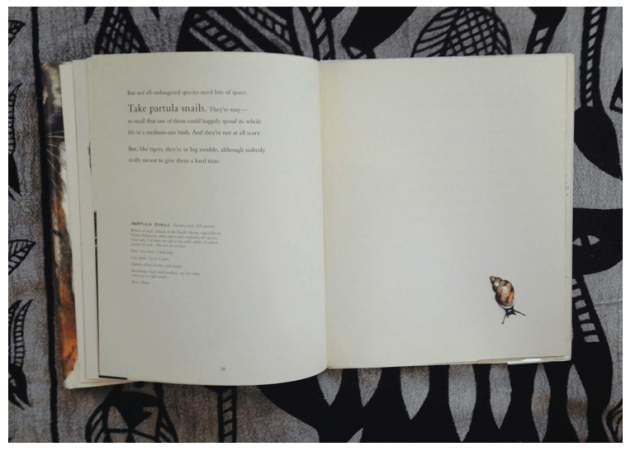Tag Archives: picture books for older readers
josephine: the dazzling life of josephine baker
Josephine: The Dazzling Life of Josephine Baker (2014).
Words by Patricia Hruby Powell, pictures by Christian Robinson.
Oh. This. Book. Dazzling, yes! But also poetic, rich, real.
(And it was just recognized as a Boston Globe-Horn Book Nonfiction honor book.Woo hoo!)
It tells Josephine Baker’s story. Of Missouri, poor and dreaming about dancing. Of racism, riots, and segregation. Of her first time dancing for pennies all the way to her last show for a sold out crowd and everything in between.
“I shall dance all my life….
I would like to die breathless,
spent, at the end of a dance.”
Josephine Baker, 1927
(Click to enlarge image(s).)
“Wasn’t there any place in the world
where color didn’t matter?”
(That place was Paris.)
“…with her beautiful ebony body,
like a prizefighter, like a kangaroo,
with rhythm in her hips,
like a cat ready to strike,
a volcano about to burst,
with her black painted lips.”
Thanks to Chronicle Books for images!
This book includes how daring and powerful and electric Josephine Baker was. But also her activism—she volunteered during WWII for the Red Cross and French Resistance; she performed for U.S. troops, unsegregated; and she adopted 12 children from varied backgrounds, her “rainbow tribe.” It also explores her faults; her decline; her comeback.
Illustrator Christian Robinson was kind enough to answer some questions and provide me with photos of Josephine Baker paired with his artwork from the book. Aren’t they incredible?!
This Picture Book Life: Was there anything during your trip to Paris that directly influenced or made it into the book?
Christian Robinson: In Paris I daydreamed and saw Josephine walking along the Champs-Élysées with Chiquita.
TPBL: How would you describe your approach to artmaking, specifically for picture books?
CR: Have fun! If I’m not enjoying the process, find a way to make it fun again.
TPBL: How did you decide what illustration you wanted to accompany the text on each page?
CR: With many rounds of rough sketches which helped give a better sense of how to lay out a picture book of this volume. When reading a manuscript I allow whatever images arise strongest in my mind to lead the way for illustration. Josephine may have been one of the most photographed women of her time, so fortunately I had plenty of visual references to help guide me as well.
TPBL: Did you make any changes to your artistic process and style considering this book’s content—for example, the spreads that deal with harsh, sad parts of the story like racism and violence?
CR: Finding ways to visually communicate the heavy and scandalous parts of Josephine’s life in a way that is accessible to children was a fun and exciting challenge. It was more liberating than limiting to express the gritty.
I had so many inspiring creative references to help guide me, such as the illustration of Paul Colin and painter Jacob Lawrence.
TPBL: Who made the decision to have some spreads be painted colorfields as background to the words without other pictures? And why?
CR: Early on it was decided that having illustration for every page would be quite a task, for both the illustrator and the reader. The beauty of [this kind of book] is that it gives pause and allows the reader to use their imagination to fill in the visuals until the next illustration. Jennifer Tolo Pierce, the art director, was able to make the most of those illustration breaks and have Patricia’s dynamic text dance across the page.
Readers, I leave you with possible cover images for the book, an artwork process photo, and a glimpse of Christian Robinson’ studio (notice the Paul Colin posters hanging on the wall).

Thanks to Christian Robinson for thoughtful answers and images!

Can We Save the Tiger?
 Can We Save the Tiger? by Martin Jenkins, illustrated by Vicky White.
Can We Save the Tiger? by Martin Jenkins, illustrated by Vicky White.
This is a beautiful book. But a sad book too.
It introduces the reader to the concept of extinction. That some animals are in danger of going away and never coming back, that some animals already have. But also that there’s still hope.
“There are so many endangered species all over the world that it’s hard to pick out some special ones.
Still, I’m sure you’ll agree that tigers are
pretty special.”
I like how the text gets into the complexities of why tigers and other animals are disappearing. Though told with clarity, this is not a simple book. It introduces the concept of invasive species. Of connectivity. It gives page time to Partula snails too. And introduces the Kakapo birds of Australia.
“…if we stop trying, the chances are that pretty soon we’ll end up with a world where there are no tigers or elephants, or sawfishes or whooping cranes, or albatrosses or ground iguanas.
And I think that would be a shame, don’t you?”
I also appreciate the way the artwork plays with scale as well as going back and forth between line drawings and painted ones. It brings the animals up close, then far away, from a sketchbook to right in front of you.
A perfect book for any budding animal-lover/conservationist.
And check out WWF’s list of endangered species and learn more about each one.











































